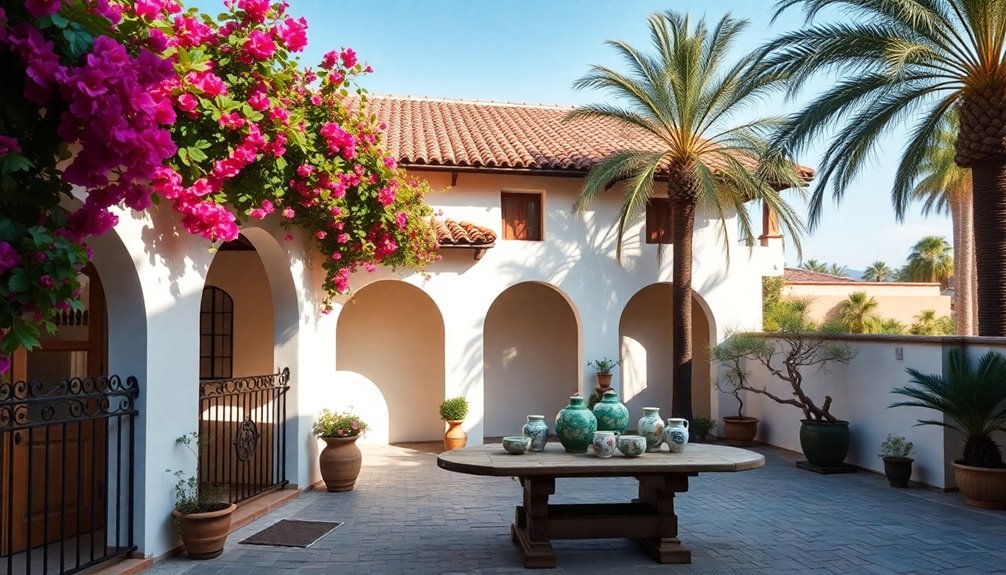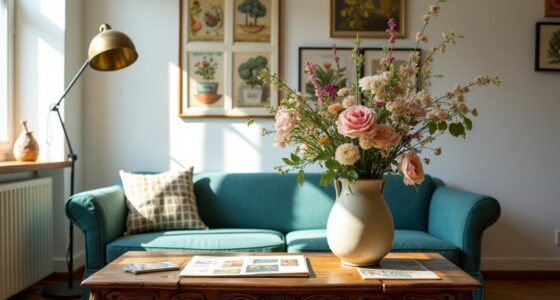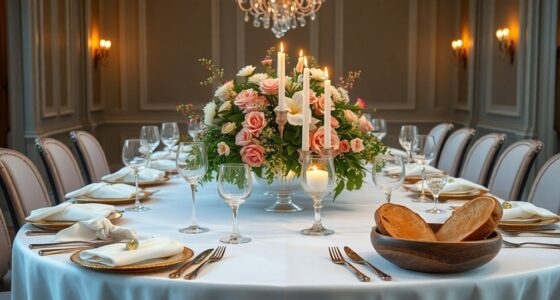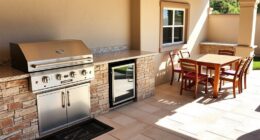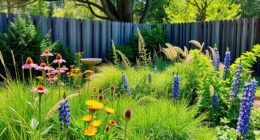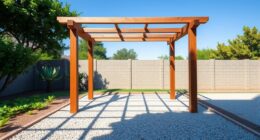Spanish Hacienda Style is a timeless architectural design that originated during Spain’s colonial period. You’ll recognize its simple rectangular shapes and the use of natural materials like adobe and stucco. Key features include thick walls for durability and energy efficiency, clay tile roofs, and charming arched doorways. Central courtyards invite outdoor living and enhance the connection with nature. Inside, exposed wooden beams and vibrant Talavera tiles add character. While rooted in history, this style adapts well to modern living, incorporating energy-efficient systems and open layouts. Stick around to explore more about its unique elements and enduring appeal. These hacienda style home features not only reflect a rich cultural heritage but also promote a serene and relaxed lifestyle. With their seamless integration of indoor and outdoor spaces, these homes create inviting atmospheres perfect for entertaining and family gatherings. Additionally, the use of sustainable materials and design practices ensures that hacienda style homes remain relevant and environmentally friendly in today’s world.
Key Takeaways
- Spanish Hacienda Style originated during the colonial period, characterized by self-sufficient estates with farms and ranches across the Americas.
- Architectural elements include stucco walls, clay tile roofs, arched doorways, and central courtyards that promote outdoor living.
- Thick adobe walls provide durability, energy efficiency, and cooling in hot climates, making them ideal for the regions they inhabit.
- The style incorporates modern amenities and smart home technology while maintaining traditional aesthetics, allowing for customizable designs.
- Distinctive interior features include exposed wooden beams, Talavera tiles, and rustic furniture, which enhance the hacienda's cultural charm.
Overview of Spanish Hacienda Style
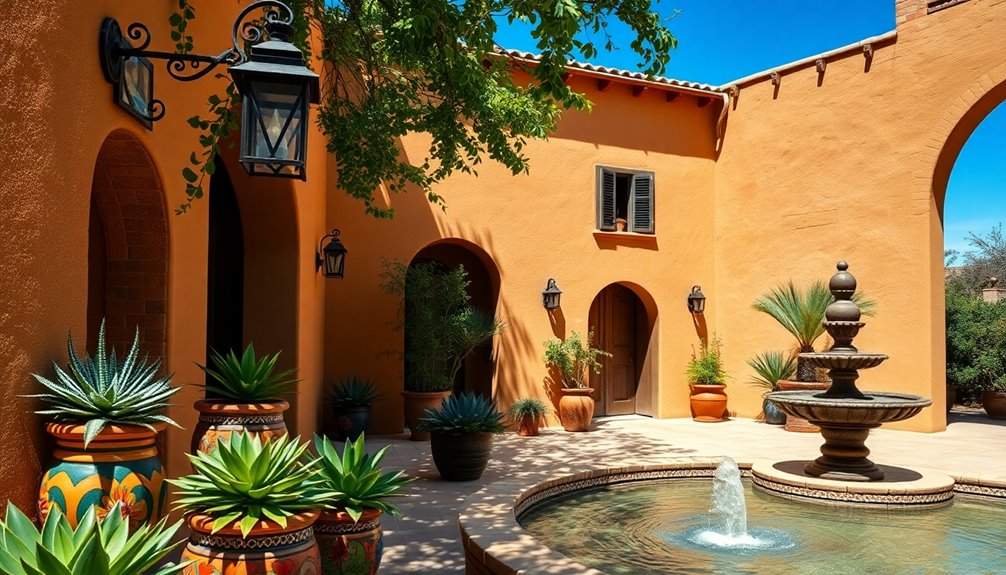
Spanish Hacienda style, which originated during Spain's colonial period, offers a unique blend of practicality and charm that reflects its historical roots.
As Spanish colonists adapted this style across the Americas, they tailored it to local climates and terrains, creating self-sufficient estates that included farms and ranches. You'll find haciendas in regions like California, Arizona, New Mexico, and Florida, showcasing a legacy that remains significant in U.S. architecture.
The design evolved to meet practical needs while maintaining aesthetic appeal. With simple rectangular shapes and natural materials, these structures embody a rustic elegance. The use of thick adobe walls not only enhances the buildings' durability but also provides excellent insulation, making haciendas energy-efficient.
The enduring popularity of Hacienda style highlights its functional and cultural importance, making it a timeless choice for homeowners seeking character and history.
Key Architectural Elements
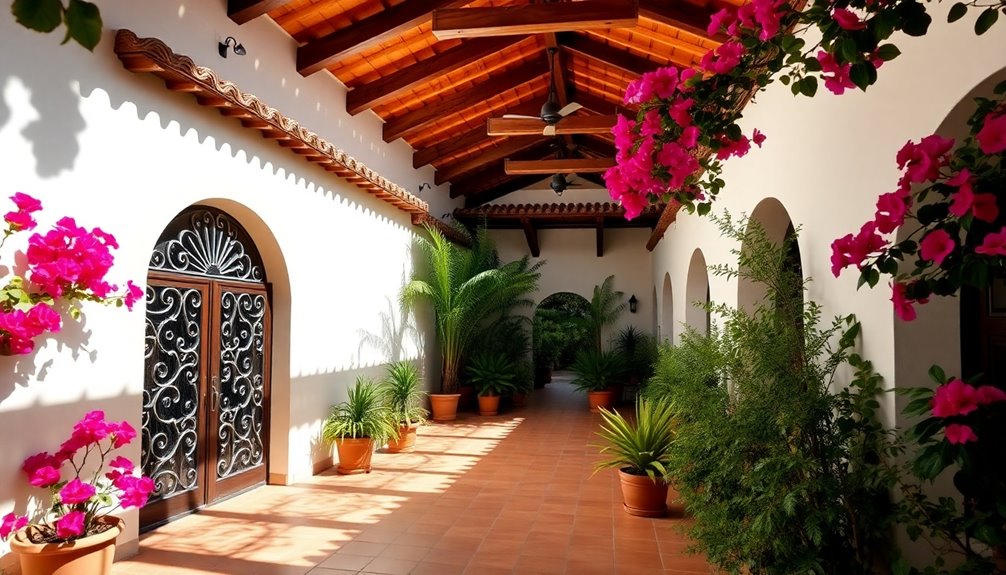
When exploring the key architectural elements of Hacienda style, you'll discover a harmonious blend of functionality and beauty.
The exterior features prominently include stucco walls, clay tile roofs, and elegant arched doorways and windows, often adorned with wrought iron accents. Central courtyards and patios invite outdoor living, while balconies offer stunning views. The use of thick walls is common as it provides cooling in hot climates.
Inside, thick adobe walls and exposed wood beams create warmth, complemented by vaulted ceilings and pointed archways that enhance spatial dynamics.
Decorative elements, like Talavera tiles and rustic hand-carved wooden doors, add cultural richness. Arches and colonnades provide shaded spaces for relaxation, and outdoor fireplaces create cozy gathering spots.
This style seamlessly integrates indoor and outdoor living, making it timeless and inviting.
Historical Origins and Influences
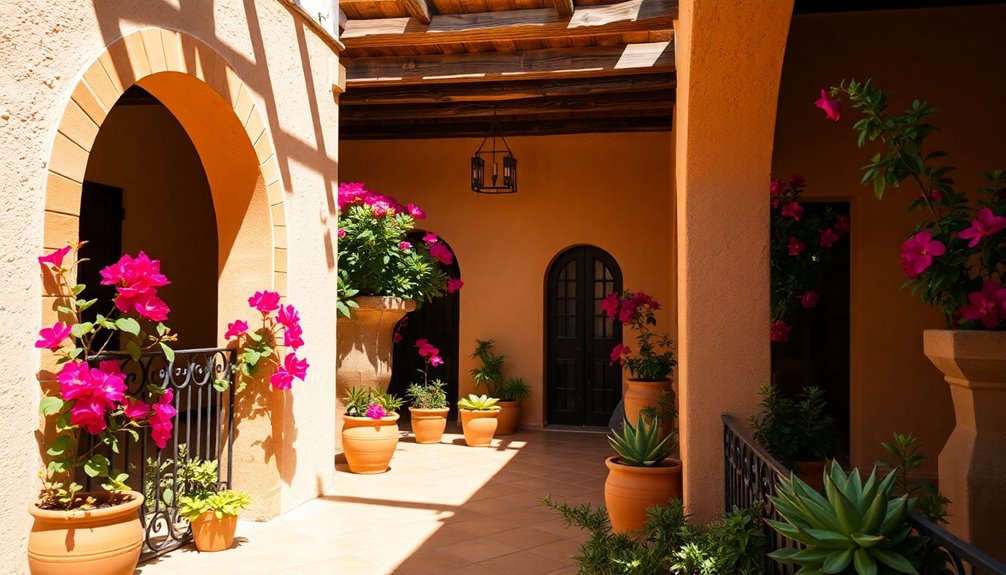
Originating from Spain, Hacienda architecture reflects a rich historical tapestry shaped by exploration and colonization.
During the Spanish Colonial Period, large rural estates known as haciendas emerged, serving agricultural and livestock needs. As conquistadors settled in the Americas, this architectural style spread, particularly to Mexico and the American Southwest.
Haciendas became symbols of wealth, showcasing royal rewards from the Spanish crown. Influenced by the Spanish Renaissance, they featured traditional building techniques, using adobe, stucco, and wood. The cultural significance of haciendas is evident in their role as market hubs that facilitated historical economic activities.
The integration of indigenous elements, like local materials and courtyard designs, added uniqueness to the style. This architectural fusion created regionally distinct variations, reflecting the cultural and economic power of their owners during the 1600s to 1800s.
Adaptation for Modern Living
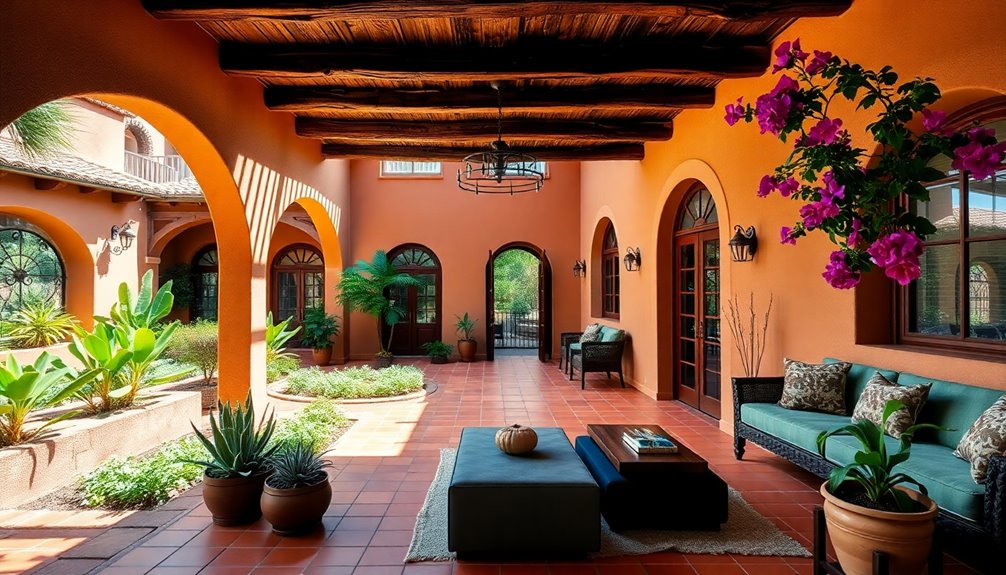
As modern lifestyles evolve, hacienda-style homes have adapted to seamlessly integrate contemporary comforts while preserving their traditional charm.
You'll find smart home technology that automates lighting, climate control, and security, making everyday living more convenient. Energy-efficient systems, modern kitchens, and stylish bathrooms enhance functionality without sacrificing aesthetics.
Open floor plans connect indoor and outdoor spaces, while large windows and sliding glass doors invite natural light. You can enjoy customizable designs that fit various budgets and preferences, often featuring lush gardens and outdoor kitchens for entertaining. The thick walls of hacienda-style homes provide excellent insulation, ensuring a comfortable atmosphere year-round.
Ultimately, the blend of rustic charm with modern amenities creates a welcoming environment that suits today's diverse lifestyles.
Distinctive Interior Design Features
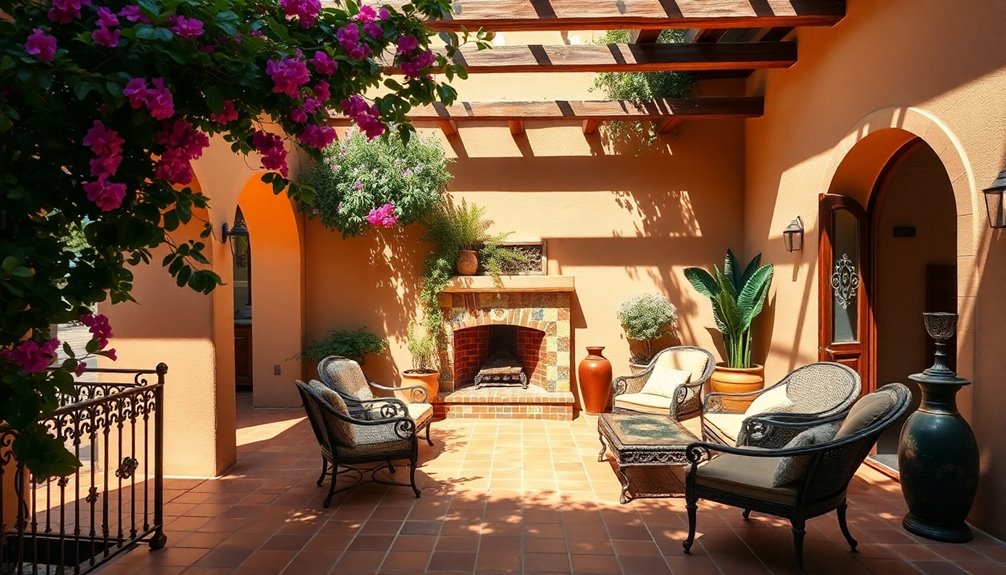
Distinctive interior design features define the hacienda style, blending rustic elements with a warm, inviting atmosphere.
You'll find adobe and stucco walls that provide durability, while clay tiles add warmth and historical craftsmanship. Dark-stained, exposed wooden beams enrich the ceilings, creating depth in your space.
Arched doorways and windows frame views elegantly, often highlighted with decorative tiles or wrought iron accents. Courtyards and patios serve as serene retreats, complete with lush landscaping and water features. The use of thick adobe walls not only enhances the authentic aesthetics but also provides excellent thermal insulation.
Inside, maximizing natural light through small windows and high ceilings keeps your home bright and airy. Rustic furniture, hand-carved details, and curated artwork further enhance the charm, perfectly reflecting the timeless essence of hacienda style.
Color Palette and Materials
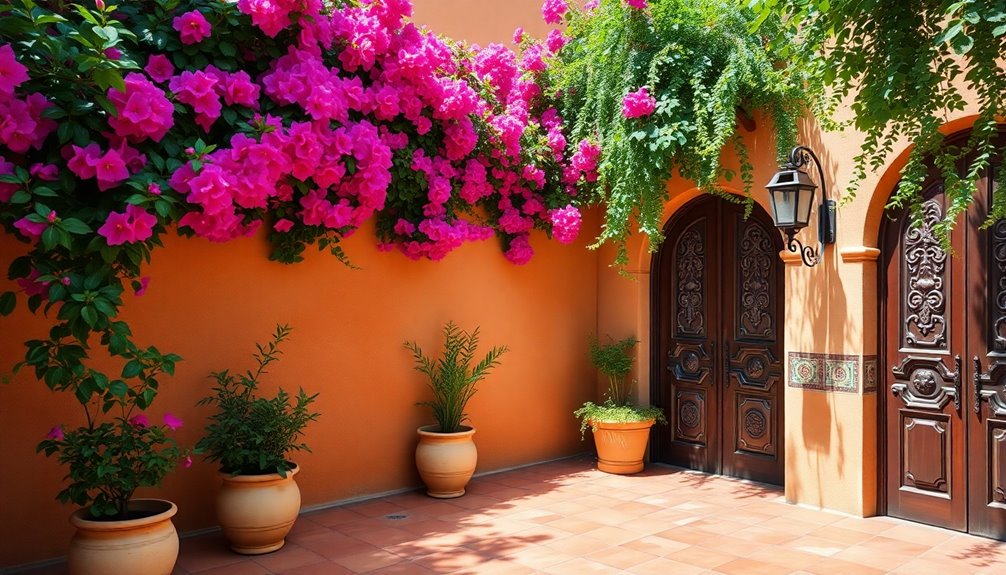
When you step into a hacienda-style home, the earthy color palette and natural materials immediately envelop you in warmth and charm.
You'll notice warm terracotta walls and ochre accents, which create a cozy atmosphere alongside deep reds and rich browns. These hues harmonize beautifully, complementing the intricate jewel tones found in Moorish-inspired decor. Earthy neutrals replace vibrant colors, enhancing the serene ambiance of the space.
Traditional materials like adobe and stucco form the structure, while clay tiles add character to floors and walls. Exposed wood beams bring rustic charm, and wrought iron accents enhance the elegance.
Talavera pottery and Spanish Colonial patterns provide delightful decorative touches, while arched doorways and textured walls draw your eye, making each space feel inviting and timeless.
Outdoor Spaces and Landscaping
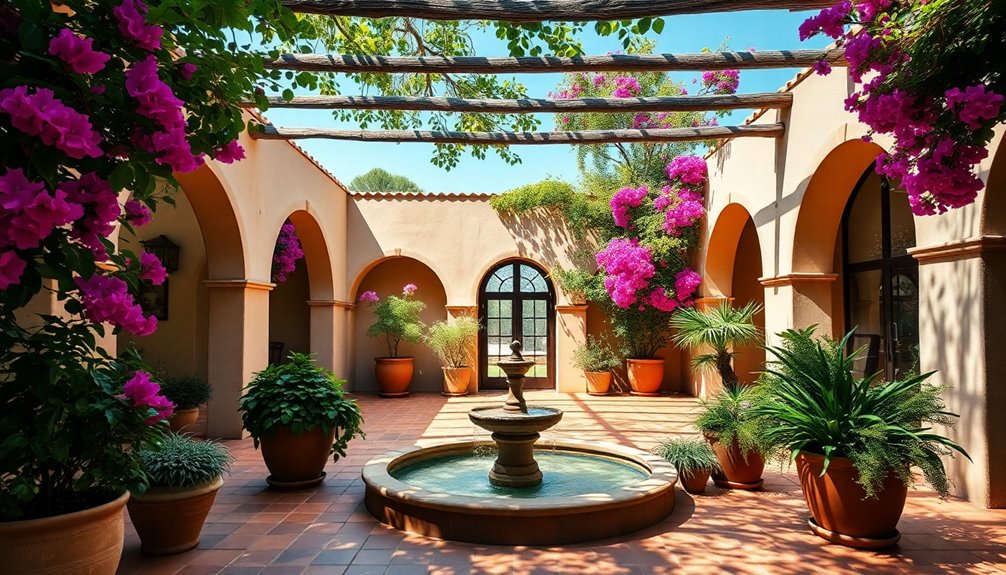
Outdoor spaces in Spanish Hacienda style homes invite you to experience a seamless blend of nature and architecture, creating a tranquil retreat right outside your door.
Courtyards and patios serve as central gathering areas, featuring paved surfaces, lush vegetation, and decorative tiles that enhance the aesthetic. The central courtyard allows natural light to flow into surrounding rooms, enhancing brightness and promoting a sense of openness.
You'll find soothing water features like fountains, which not only create a calming atmosphere but also serve as visual focal points.
Raised beds and stone pathways encourage exploration, while cozy outdoor fireplaces or chimineas provide warmth and charm for evening gatherings.
With earth-toned decor and Spanish-inspired tiles, these outdoor spaces foster relaxation and social interaction, making them perfect for enjoying the beauty of your surroundings.
Frequently Asked Questions
How Does Spanish Hacienda Style Differ From Other Architectural Styles?
Spanish Hacienda style sets itself apart from other architectural styles through its sprawling layouts, low-pitched clay tile roofs, and rustic yet functional design.
You'll notice small windows aimed at maximizing airflow while minimizing direct sunlight. The integration of grand courtyards invites outdoor living, while earthy color palettes and exposed wood beams create a warm atmosphere.
This style emphasizes self-sufficiency and practicality, reflecting its historical roots more than the ornate details found in other designs.
What Are Common Misconceptions About Spanish Hacienda Architecture?
Many misconceptions muddle the marvelous image of Spanish Hacienda architecture.
You might think haciendas are solely Spanish, but they've evolved in the Americas.
Don't assume they're always spacious; some are snug and sophisticated.
While they originated in warm climates, modern designs adapt to any weather.
You'll find intricate details, not just plain surfaces, and they can marry traditional charm with contemporary comforts.
This style's versatility truly makes it a timeless treasure!
Which Regions in the U.S. Prominently Feature Spanish Hacienda Style Homes?
You'll find Spanish hacienda style homes prominently in regions like California, Florida, Arizona, and New Mexico.
Each area boasts unique adaptations to its climate, featuring stucco exteriors, clay tile roofs, and central courtyards.
In California, for instance, the thick adobe walls keep homes cool during the day.
Meanwhile, Florida's haciendas blend traditional elements with modern amenities, making them popular choices across these diverse landscapes.
Are There Modern Examples of Spanish Hacienda Style in Urban Settings?
Yes, you can find modern examples of Spanish hacienda style in urban settings.
These homes often feature compact layouts with multi-functional areas, blending traditional elements with contemporary design.
You'll notice sustainable features like rainwater collection and smart home technology, enhancing convenience.
Earthy color palettes and natural materials maintain authenticity, while expansive patios and courtyards create inviting outdoor spaces.
This style beautifully adapts to urban life, preserving its cultural heritage while meeting modern needs.
What Maintenance Practices Are Recommended for Hacienda-Style Homes?
Wondering how to keep your hacienda-style home looking its best? Regular exterior maintenance is crucial; check stucco walls for cracks and clean clay tile roofs annually.
Inside, polish your terracotta floors and restore wooden beams to preserve charm.
For outdoor spaces, maintain lush gardens and ensure balconies are safe.
Don't forget to incorporate modern updates discreetly, ensuring they blend seamlessly with your home's timeless architecture.
Your efforts will keep its beauty alive!
Conclusion
In the world of design, Spanish Hacienda style is like a warm embrace from a sun-drenched afternoon. It invites you to find comfort in its earthy colors and rustic charm, reminding you that true beauty lies in simplicity and connection to nature. Just as a sturdy tree flourishes with deep roots, your home can thrive when it reflects history and character. Embrace this timeless style, and let your living space tell a story of warmth and tradition.
